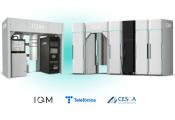Researchers Develop Technique to Recover and Recycle Quantum Dots in Microscopic Lasers
November 25, 2024 -- Researchers have discovered a way to recycle the tiny particles used to create supraparticle lasers, a technology that precisely controls light at a very small scale.
The breakthrough could help manage these valuable materials in a more sustainable way.
Supraparticle lasers work by trapping light inside a tiny sphere made of special particles called quantum dots, which can absorb, emit, and amplify light very efficiently.
They are made by mixing quantum dots in a solution that helps them stick together in tiny bubbles. However, not all attempts succeed, and even successful lasers degrade over time. This leads to wasted materials, which can be expensive.
Recycling method
The idea to recycle these particles came up during a team discussion about the high cost of wasted quantum dots. Dillon Downie, a PhD student in the Institute of Photonics at the University of Strathclyde, suggested a potential solution, and with the support of the team leader Dr Nicolas Laurand, they tested the idea. To their surprise, they were able to recover and reuse the particles to make new lasers.
Dillon said: “Supraparticle lasers are already beginning to be used for targeted drug delivery and sensing applications, as well as for components in compact electronic systems. Nanoparticle aggregates and supraparticle lasers are expected to play an increasingly prominent role in everything from wearable medical devices to ultrabright LEDs.
In a paper, entitled “Recycling self-assembled colloidal quantum dot supraparticle lasers” published in the journal Optical Materials Express, the Strathclyde researchers describe how they recycled quantum dots from used lasers to make new ones that work just as well as the originals.
Dillon said: “We envision this method being used to extend the life cycle of supraparticles, which could be repurposed for various applications such as medical biosensors, representing a significant advance toward sustainable nanoengineering.”
Simple method
The recycling process starts by breaking apart the used lasers by heating the particles and exposing them to sound waves. The quantum dots were then separated from impurities using a mix of oil and water, followed by filtering and coating the particles to restore their properties. Finally, the research team tested the recycled dots to ensure they could still emit light effectively and used them to create new lasers.
This method recovered 85% of the original quantum dots, which still performed almost as well as new ones. The recycled dots were then used to make lasers that worked just like the originals.
The team plans to study how recycling affects the performance of the quantum dots over time and to develop ways to recycle more complex or specialised particles.
Dillon added: “Our simple method doesn’t need fancy equipment, so it can be used in most labs. This is a big step toward making advanced materials more sustainable.”




































